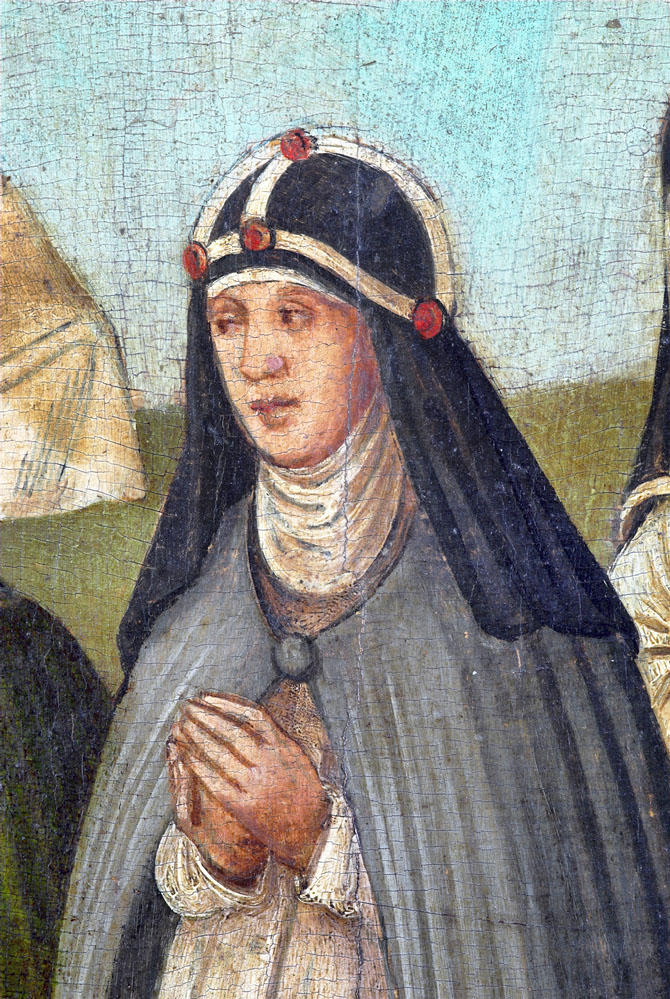|
Bridgettine Religious Sisters
The Bridgettines, or Birgittines, formally known as the Order of the Most Holy Savior (; abbreviated OSsS), is a monastic religious order of the Catholic Church founded by Saint Birgitta or Bridget of Sweden in 1344, and approved by Pope Urban V in 1370. They follow the Rule of Saint Augustine. There are today several different branches of Bridgettines. History The first monastery of the order was founded in 1369 at the former royal castle of Vadstena. St. Bridget's granddaughter, Lady Ingegerd Knutsdotter, was Abbess of Vadstena from 1385 to 1403. Upon her death on 14 September 1412, direct descent from St. Bridget became extinct. This opened the medieval concept of "Bridget's spiritual children", members of the order founded by her, to be her true heirs. The order spread widely in Sweden and Norway, and played a remarkable part in promoting culture and literature in Scandinavia; to this is to be attributed the fact that the motherhouse at Vadstena, by Lake Vättern, was not ... [...More Info...] [...Related Items...] OR: [Wikipedia] [Google] [Baidu] |
Katerina Lemmel
Katerina Lemmel, née Imhoff (born 1466 in Nuremberg; died March 28, 1533 in Maihingen; also ''Katharina Lemmel'', ''Katharina Lemlin'') was a successful patrician businesswoman in Nuremberg who became a Birgittine nun at the monastery of Maria Mai in Maihingen in Nördlinger Ries. A collection of letters that she wrote from the monastery to her relatives in Nuremberg permits multifaceted insights into life in a late-medieval female monastery and into its system of spiritual economies. Years in Nuremberg Katerina was born the third child of Paulus Imhoff and Ursula Holzschuher Imhoff. Both her parents came from important patrician families. The Nuremberg patriciate formed the thin governing crust of the imperial city that consisted of about forty families. At the age of eighteen, Katerina Imhoff married the Bamberg patrician and businessman Michel Lemmel who soon took up Nuremberg citizenship. In her years in Nuremberg, Katerina Lemmel became a successful businesswoman holdin ... [...More Info...] [...Related Items...] OR: [Wikipedia] [Google] [Baidu] |
Vättern
Vättern ( , ) is the second largest lake by surface area in Sweden, after Vänern, and the sixth largest lake in Europe. It is a long, finger-shaped body of fresh water in south central Sweden, to the southeast of Vänern, pointing at the tip of Scandinavia. Being a deep lake at or below sea level at its deepest point, Vättern is about 1/3 the surface area of Vänern but in spite of this contains roughly 1/2 of its water. Vättern drains into Motala ström through Bråviken into the Baltic Sea, but also has a downstream connection since 1832 through Göta Canal to Vänern and the Kattegat tributary of the Atlantic Ocean. The lake has plenty of sources from rivers and small lakes, with the highest located sources being near Nässjö on the South Swedish Highland near the southeastern shoreline. Name The name Vättern is closely related to "vatten", the Swedish word for water, and also means "water, lake". Geography The lake's total surface area is about , with a drainage ba ... [...More Info...] [...Related Items...] OR: [Wikipedia] [Google] [Baidu] |
Martyr
A martyr (, ''mártys'', "witness", or , ''marturia'', stem , ''martyr-'') is someone who suffers persecution and death for advocating, renouncing, or refusing to renounce or advocate, a religious belief or other cause as demanded by an external party. In the martyrdom narrative of the remembering community, this refusal to comply with the presented demands results in the punishment or execution of an actor by an alleged oppressor. Accordingly, the status of the 'martyr' can be considered a posthumous title as a reward for those who are considered worthy of the concept of martyrdom by the living, regardless of any attempts by the deceased to control how they will be remembered in advance. Insofar, the martyr is a relational figure of a society's boundary work that is produced by collective memory. Originally applied only to those who suffered for their religious beliefs, the term has come to be used in connection with people killed for a political cause. Most martyrs are consid ... [...More Info...] [...Related Items...] OR: [Wikipedia] [Google] [Baidu] |


